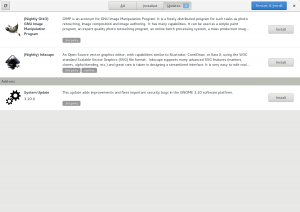Here’s a little Christmas present. This is GNOME Software working with xdg-app to allow live updates of apps and runtimes.

This is very much a prototype and needs a lot more work, but seems to work for me with xdg-app from git master (compile with --enable-libxdgapp). If any upstream projects needed any more encouragement, not including an AppData file means the application gets marked as nonfree as we don’t have any project licensing information. Inkscape, I’m looking at you.
Published by
hughsie
Richard has over 10 years of experience developing open source software. He is the maintainer of GNOME Software, PackageKit, GNOME Packagekit, GNOME Power Manager, GNOME Color Manager, colord, and UPower and also contributes to many other projects and opensource standards. Richard has three main areas of interest on the free desktop, color management, package management, and power management.
Richard graduated a few years ago from the University of Surrey with a Masters in Electronics Engineering. He now works for Red Hat in the desktop group, and also manages a company selling open source calibration equipment. Richard's outside interests include taking photos and eating good food.
View all posts by hughsie

Can GNOME Software be packaged (and executed) itself as a xdg-app?
I would like to try it on my debian jessie laptop (using Alex’s deb’s repository for xdg-app)
Thank you for your work!
Yes, although ‘d need to ship a list of “approved” repos — something that I’m planning to work on more next year :)
LOLWHAT? Man, you need to think about user needs too. Why not to make Gnome-software adequate and usable before? Why do you close this https://bugzilla.gnome.org/show_bug.cgi?id=759950 without explaning?
GNOME Software probably isn’t what you’re looking for. You probably want to try GNOME Packages or even yumex.
No, no, no. The point is that GNOME Software must be a fully-operational software center – why do you send users that want to install a console app, drivers or whatever else to terminal read mans about pm usage? Where is the idea about lazy desktop? I mean, I want to be able to tell someone e.g. “Yeah, it’s simple, just go to Software start typing livestreamer, and you’ll see that app that i was talking about”.
I’ve started topic on my native language forum, some people said that its a cool idea, some said that it’ll not realized because of HiG (now it sounds like nazi ideology to me), some said “use dnf”, but no one said that it is bad idea or that is software center became too complicated because of that.
Personnaly, I use dnf, but only because Software doesn’t show me the full picture (and another bug).
At the moment i tell newbies that using Software is a bad idea, because it lacks of functionality, but I believe that it can be changed.
Yumex-dnf is bad, i even cant update just one firefox packages with it. And what is GNOME Packages? I tried to google but cannot find. Please share the link.
Software != packages. You can install non GUI applications, just search for metainfo in the appstream specification. In GNOME we try to do as much for the user as possible; so rather than manually specifying the codecs in the software center, we should automatically install them when media files are played for the first time. For gnome packages, just search for “packages” in gnome-software. The executable is gpk-application if that helps.
I understand that you want gnome-software only for software and that is reasonable but problem is when you search for package that is not in gnome software but is in repositories (even GUI programs, for eg. steam, openshot). You would open gnome software, search, find out that it is not there and then go to gnome-package-installer or terminal and search again. That’s driving people away from gnome software and forcing to use other tools.
I think it would be bad idea to mess software with packages but instead all, installed, updates tabs there could have been software, packages, installed, updates and everyone would be happy.
I really don’t think just exposing the packages is the way to solve a problem. If you’re looking for an app without appdata then the best thing to do is add the appdata file to the upstream project. If you’re looking for devel files or libraries you’re using the wrong tool for the job.
Ok. I got it. Thanks for an explanation. I dont like this system personally, but it make sense.
Hmm… I cant find mesa-vdpau-drivers in Packages even after “Refresh Package Lists” (dnf see it), but I guess it’s Fedora problems.
Good luck to you & Happy New Year!